Related Flashcards
Related Topics
Cards In This Set
| Front | Back |
|
1 Voluntary liquidation: s84 Insolvency Act (IA 1986) If a company finds itself in financial difficulty,what are the two main options
available?
|
1 Voluntary liquidation: s84 Insolvency Act (IA 1986) 1) Administration. This aims to rescue the company so that it may continue trading
as a going concern. 2) Liquidation. This winds up the company, thus bringing its life to an end.
|
|
1 Voluntary liquidation: s84 Insolvency Act (IA 1986) When does a voulentary liquidation occur? What type of resolution is required?
|
1 Voluntary liquidation: s84 Insolvency Act (IA 1986) A voluntary liquidation occurs where the members pass a resolution to go into
liquidation. - Where the period fixed for the duration of the company expires or an event
occurs upon which the articles provide that a company should be wound up, an
ordinary resolution must be passed.- A special resolution must be passed if the company is being wound up for
any other reason.
|
|
1 Voluntary liquidation: s84 Insolvency Act (IA 1986) What are the two types of voulentary liquidation?
|
1 Voluntary liquidation: s84 Insolvency Act (IA 1986) 1) A members' voluntary liquidation is used where the company is solvent 2) A creditors' voluntary liquidation is used where the company is insolvent
|
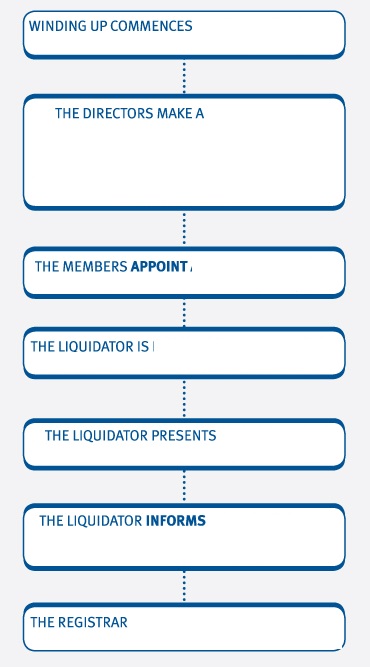 1 Voluntary liquidation: s84 Insolvency Act (IA 1986) Members' voluntary winding up |
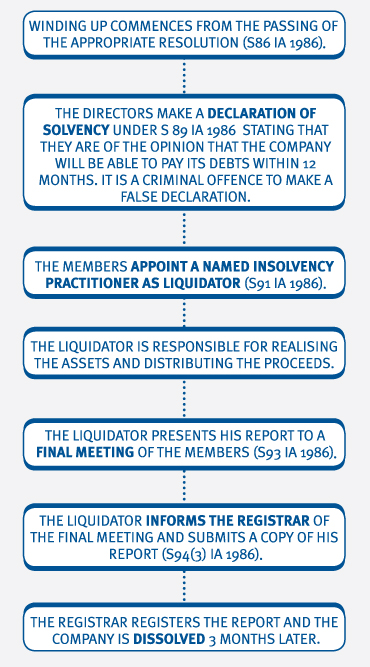 1 Voluntary liquidation: s84 Insolvency Act (IA 1986) |
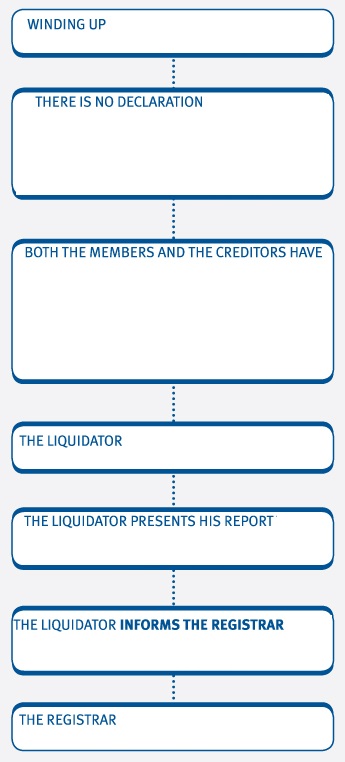 1 Voluntary liquidation: s84 Insolvency Act (IA 1986) Creditors' voluntary winding up |
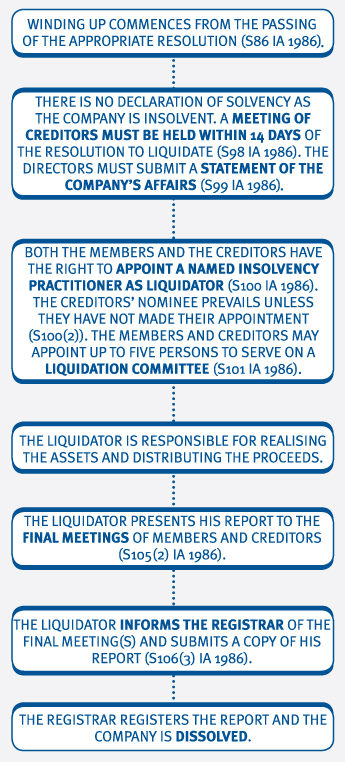 1 Voluntary liquidation: s84 Insolvency Act (IA 1986) |
|
1 Voluntary liquidation: s84 Insolvency Act (IA 1986) Converting a members' voluntary liquidation into a creditors' voluntary
liquidation- Why would this happen?- How is it done?
|
1 Voluntary liquidation: s84 Insolvency Act (IA 1986) If the liquidator discovers
that the company’s debts will not be paid in full within the time specified in
the declaration of solvency, he must convert the members’ voluntary liquidation
into a creditors’ voluntary liquidation. This is done by convening a meeting of
the company’s creditors. At the meeting the liquidator must:- lay before the creditors a statement of affairs- invite the creditors to appoint a different insolvency practitioner as
liquidator- invite the creditors to appoint a liquidation committee
|
|
2 Compulsory liquidation When will a compulsory winding up commence? What are the grounds for petition?
|
2 Compulsory liquidation A compulsory winding up
commences when a petition for a winding up order is presented to the court. The
possible grounds for the petition are set out in s122 IA 1986:- The company has passed a special resolution to be wound up by the court.- A public company has not been issued with a trading certificate within a year of
incorporation.- The company has not commenced business within a year of being incorporated or
has suspended its business for over a year.- The company is unable to pay its debts. A company is deemed to be unable to pay
its debts where a creditor who is owed at least £750 has served a written demand
for payment and the company has failed to pay the sum due within three weeks.- It is just and equitable to wind up the company. However, the court will not
make an order under this ground if some other more reasonable remedy is
available.
|
|
2 Compulsory liquidation Who may
petition the court for a compulsory liquidation?
|
2 Compulsory liquidation - the company itself- the Official Receiver, who is a civil servant in The Insolvency Service and is
an officer of the Court- the Department for Business, Innovation and Skills- a contributory. This is any person who is liable to contribute to the assets of
the company when it is being wound up. (The contributory must prove that the
company is solvent).- a creditor who is owed at least £750.
|
|
2 Compulsory liquidation What are the effects of winding-up petition?
|
2 Compulsory liquidation - All actions for the recovery of debt against the company are stopped- Any floating charges crystallise.- Any legal proceedings against the company are halted, and none may start unless
leave is granted from the court.- The company ceases to carry on business except where it is necessary to complete
the winding up, e.g. to complete work-in-progress.- The powers of the directors cease, although the directors remain in office.- The employees are automatically made redundant, but the liquidator can re-employ
them to help him complete the winding up.
|
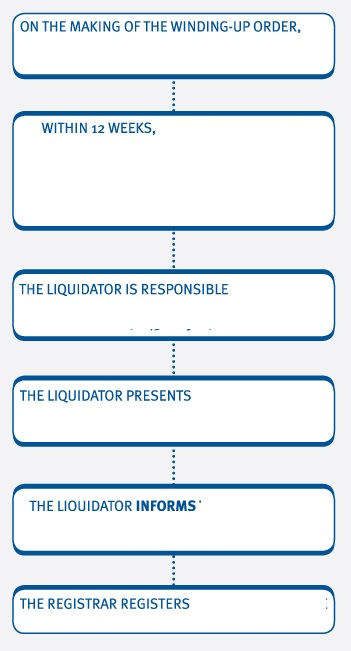 2 Compulsory liquidation Subsequent procedures |
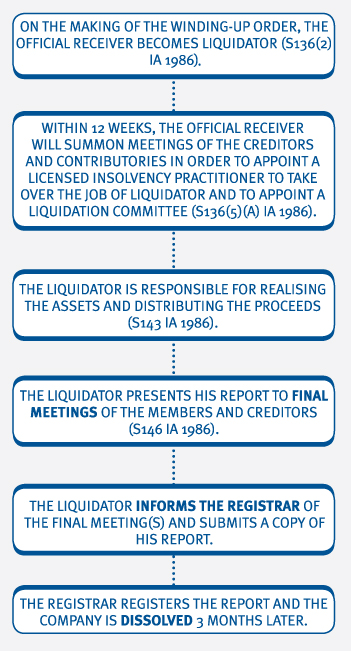 2 Compulsory liquidation |
|
2 Compulsory liquidation In what order must the liquidator must repay
debts?
|
2 Compulsory liquidation - fixed charge-holders - expenses of liquidation - preferential creditors: - wages or salaries due in the four months preceding the commencement of winding
up (maximum £800 per employee) - all accrued holiday pay - All preferential creditors rank equally amongst themselves. - floating charge-holders - unsecured creditors – rank equally amongst themselves. The Enterprise Act 2002
introduced into the Insolvency Act 1986 a ring-fencing mechanism where part of
assets which are subject to a floating charge are available to unsecured
creditors. The amount ring-fenced is 50% of the first £10,000, plus 20% of the
rest up to a maximum ring-fenced fund of £600,000. - post-liquidation interest. - members – declared but unpaid dividends. - members – return of capital (in accordance with class rights). - any surplus to be distributed to members.
|
|
3 Administration What is administration?
|
3 Administration Administration involves the
appointment of an insolvency practitioner, known as an administrator, to manage
the affairs, business and property of a company. It was first introduced by
Schedule 16 IA 1986, but has subsequently been amended by the Enterprise Act
2002.
|
|
3 Administration What does administration hope to achieve?
|
3 Administration - rescue a company in financial difficulty with the aim of allowing it to continue
as a going concern - achieve a better result for the creditors than would be likely if the company
were to be wound up - realise property to pay one or more secured or preferential creditors.
|
|
3 Administration Who can appoint an administrator?
|
3 Administration - the court in response to a petition by a creditor, the directors or the
company itself - the holder of a qualifying floating charge over the company's assets - the company or its directors provided that winding up has not already begun.
|
|
3 Administration When will the court appoint an administrator?
|
3 Administration The court will only agree to appoint an administrator if it is satisfied that the company is or is likely to become unable to pay its debts, and the administration order is likely to achieve its objectives
|





